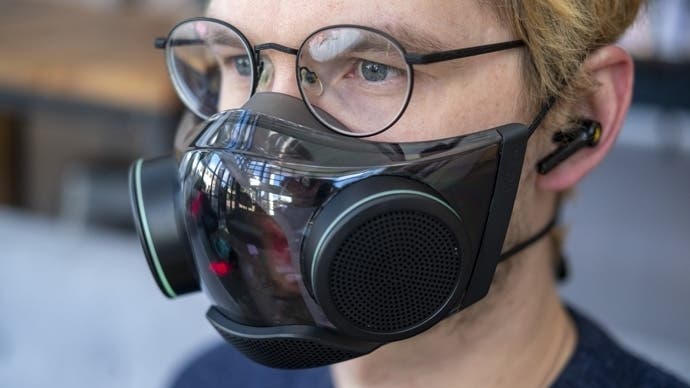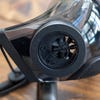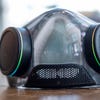Razer Zephyr review: relic of a dark future
The unlikely wearable air purifier from the kings of RGB.
Debuting as 'Project Hazel' at the CES trade show earlier this year, Razer's wearable air purifier and face mask is now a genuine product called the Zephyr that retails for £99. The idea here is to provide a constant supply of air in and out, purified to an N95 standard to help prevent the spread of viruses, while also providing a distinct look complete with RGB lighting. Razer very kindly sent me one of the few units earmarked for the UK press ahead of its full reveal as part of RazerCon 2021, and so I've been testing it for the past few days to see whether it really lives up to the hype.
Looking at the Zephyr, the design here is quite similar to dual-filter half masks used for painting or working in similarly noxious environments, with fans on each cheek drawing air through circular filters, before expelling through another filtered grille at the base of the mask. Medical-grade silicone creates a seal around your nose and mouth, while a pair of straps (one adjustable, one not) go around the back of your head to hold the Zephyr in place.
Other elements of the design are more novel, including a transparent and illuminated mouth cover intended to make your words and expressions visible; a small bottle of anti-fog spray is also included in case the airflow alone isn't sufficient. There's also RGB lighting encircling each circular intake. Power, Bluetooth pairing and fan speed can be controlled via a single button on the side of the right air intake, while the Zephyr smartphone app allows you to choose lighting colours and effects for each of the two lit zones. Lighting can also be disabled entirely.
Actually wearing the Zephyr is surprisingly comfortable. The half-mask weighs about as much as a lightweight gaming headset, around 237 grams all-in, and the straps do a good job of keeping the Zephyr stable on your face. I wouldn't go jogging or start head-banging with this on, but it's certainly fine for walking and other gentle movement.
Wearing the mask at home was one thing, but wearing it in public was another. You can certainly expect to receive a lot of attention while wearing one of these, not all of it positive in an era where mask-wearing remains a divisive issue. I personally enjoyed this - I really love talking about interesting bits of technology - but I can certainly foresee a situation where I wear a standard cloth mask instead because I simply don't want to get into a conversation.
One thing that surprised me was the noise produced by the small-diameter fans. At their low speed (4200RPM) setting, they produce a gentle whine that's easy to drown out with ambient noise, but at their high speed setting (6200RPM) they'll definitely be audible to someone sitting next to you - so social distancing and a pair of good noise-cancelling headphones are probably best practice.
In terms of practicality, the Zephyr does have a few drawbacks. The app sternly instructs you not to use for the provided N95 filters for more than twenty-four hours before swapping them for a new set (so just like Metro then, but slightly less frantic). You get three sets of filters in the box, which translates into nine days of use, assuming you keep the mask turned on for eight hours a day. If you only need to use it for an hour's commute in the morning and the same again in the evening, then you'll go for 36 days before needing to buy additional filters. It's possible we'll see third-party filters, but the specific shapes required - especially the smile-shaped mouth filter - means that they'll need to be made for the Zephyr specifically.
Further filters can be bought separately, costing £30 for 10 sets. That means you'd be able to use the Zephyr for 8 hours a day for 30 days for £30 - not cheap, but also not unreasonable compared to the cost of buying disposable masks to last for the same period. If you want to get more filters right from the off, you can also get the Zephyr in a £150 'starter kit' which includes 33 sets of filters and the smart mask itself.
You also need to keep the mask topped up with power to keep its fans spinning, especially if you're using the top fan setting with both RGB zones illuminated - Razer rate the mask's battery life at just 3.5 hours when used at max settings. Disabling RGB (which isn't too visible in moderate sunlight anyway) brings this up to four hours, while using the lower fan speed mode without RGB gets you a more reasonable eight hours. (These figures are provided by Razer, by the way; I haven't had time to run proper battery life tests yet but I will update this piece when I do.) Thankfully, charging is done via USB-C, so if you already have an Android phone, recent Apple tablet, in-ear headphones, etcetera, you've likely already got a suitable charger within arm's reach.
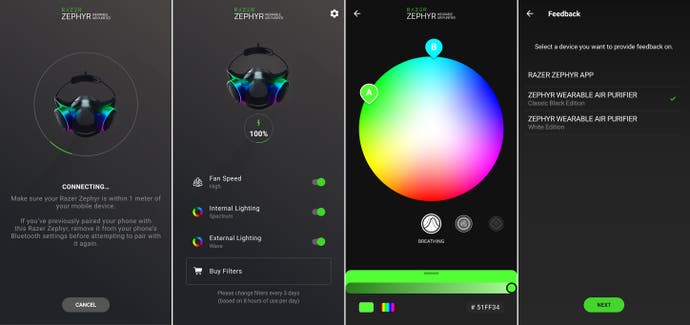
The Zephyr also doesn't include the voice amplifier imagined for the original Project Hazel device. Razer says that it made the mask too heavy, hindered breathability and reduced battery life, which are all fairly valid reasons to remove it. That means you'll need to provide your own Bane impressions while wearing it, sadly. Another cool feature, the UV-cleaning charging case, has also been ditched - you just get a soft cloth case for it instead, which doesn't provide much protection, but presumably costs far less. These are disappointing omissions, but then again the drawbacks for including features at the 'conception' and 'production' stages vary pretty massively - and I'd rather get a workable device with fewer features than something true to the initial dream but completely impractical (a la Homer's famous automobile).
After spending a few days with the Zephyr, I've come to quite like it. It's comfortable to wear, a cool conversation-starter for suitably nerdy audiences and it purports to serve a very important function in reducing the spread of viruses like COVID or flu. (I have no way of testing Razer's efficacy claims with regards to filtration, so I will leave it to better-equipped outfits to perform this important function!) The RGB lighting looks cool and the see-through mouth cover is very sensible too, even though the Zephyr is far from the only mask to use this idea. The filters and the charging are a nuisance but not a significant one for now - so I'll keep the Zephyr in my bag whenever I travel by public transport. (Mind you, I'll still keep a cloth mask with me too - especially as the Zephyr isn't water resistant and shouldn't be worn in the rain, a remarkably common occurrence in our sceptered isle.) If you currently spend a fair chunk of change on disposable N95 masks, then going for the Zephyr instead could be a sensible investment - and it's arguably better for the planet if you're just replacing a few filters rather than a complete mask each time, assuming you use the Zephyr for months and months.
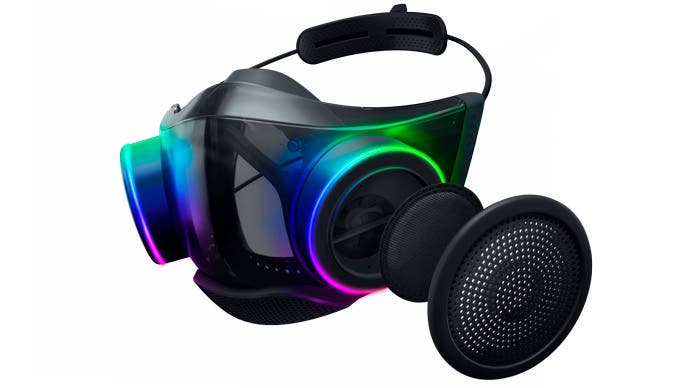
While the Zephyr does serve a very timely function, this isn't its real purpose - more importantly, it's a halo product that exists to shine an RGB light on one of the globe's biggest gaming brands, to spark conversations and ultimately translate into sales of Razer's laptops and peripherals. By that measure, it certainly succeeds. The fact that it's been one of the few Razer projects to debut as a CES prototype and then make it as an actual retail product speaks to the publicity it's enjoyed already - and the chops of Razer's design teams, working on a product that's far from the keyboards, mice, headsets and laptops that typify the company's traditional offerings.
That theme of exploring new product categories is one that Razer has embraced this year, with today's RazerCon 2021 announcements also including their first PC components - AIOs, case fans, fan controllers and power supplies. Unsurprisingly, most are decked out with RGB and purport to offer high performance. We'll look to get some of these items in to test, and look forward to sharing our findings in the weeks and months to come.
